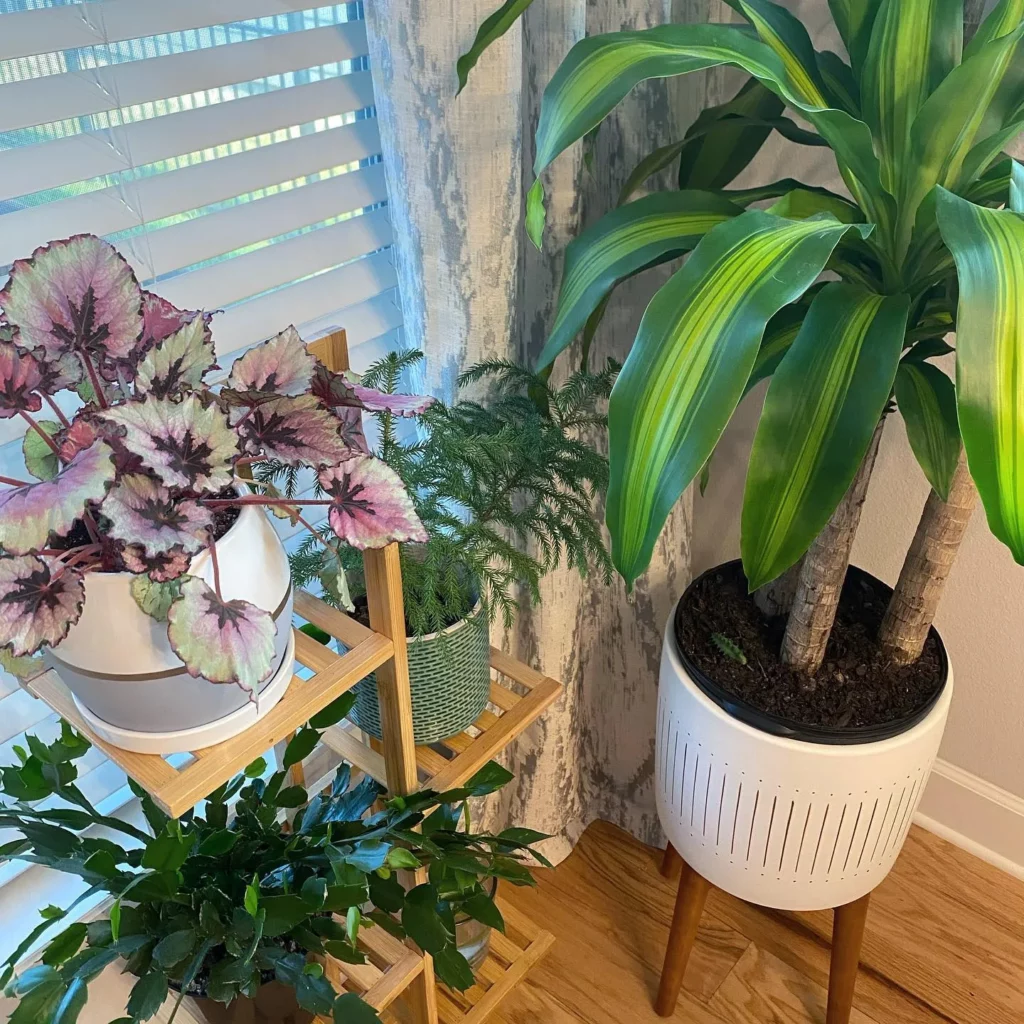Corn Plants are beloved for their captivating appearance, showcasing long and gracefully arching foliage that adds a touch of natural elegance to any space. One of their defining features is their vibrant green leaves, which create a refreshing ambiance in your home or office environment.
Understanding the Appearance of Corn Plants

The foliage of Corn Plants is characterized by its rich, vibrant shade of green, evoking a sense of freshness and vitality. These lush leaves not only enhance the visual appeal of the plant but also contribute to its overall health and growth.
When it comes to size, Corn Plants can reach impressive heights. Typically, they grow to be around 5 to 6 feet tall, making them a statement piece in any room. The broad and elongated leaves, with their slightly wavy edges, create a striking visual impact, complementing the overall appearance of the plant.
Whether you place your Corn Plant in a corner or as a focal point, its distinctive foliage is sure to catch the eye of anyone who enters the room. The vibrant green leaves not only add a touch of nature indoors but also create a soothing atmosphere, promoting a sense of calm and tranquility.
Key Features of Corn Plant Appearance:
- Long and arching vibrant green leaves
- Height of around 5 to 6 feet
- Broad and elongated leaf shape with slightly wavy edges
Now that you have an understanding of the beautiful appearance of Corn Plants, let’s explore how to care for them to ensure their continued vitality and growth.
Meeting Light Requirements for Corn Plants

Corn Plants (Dracaena fragrans) are a wonderful choice for indoor environments with limited natural light. These plants thrive in indirect sunlight, making them perfect for homes and offices that have low-light conditions. To ensure your Corn Plant receives the right amount of light, follow these tips:
No products found.
- Place your Corn Plant near a north or east-facing window where it can receive bright, indirect sunlight. Avoid exposing it to direct sunlight as it can scorch the leaves.
- If your space doesn’t have access to natural light, you can use fluorescent lights or grow lights specifically designed for indoor plants. Position the lights about 12-18 inches above the plant and keep them on for 12-16 hours a day.
- Rotate your Corn Plant every few weeks to ensure even light distribution and prevent the plant from leaning towards the light source.
Watering Your Corn Plant: Dos and Don’ts

Proper watering is crucial for the health of your Corn Plant. To ensure optimal growth and prevent issues like overwatering or underwatering, follow these essential tips:
No products found.
- Check moisture levels: Before watering, check the moisture levels in the soil. Stick your finger about an inch deep into the soil – if it feels dry, it’s time to water.
- Avoid overwatering: Corn Plants prefer slightly dry soil rather than constantly wet conditions. Overwatering can lead to root rot and other problems. Make sure the top layer of soil dries out between waterings.
- Water thoroughly: When you do water, make sure to thoroughly soak the soil until water drains out from the bottom of the pot. This helps to flush out any accumulated salts and ensures even distribution of moisture.
- Consider the season: In spring and summer, when the plant is actively growing, it may require more frequent watering. During winter, when growth slows down, you’ll need to reduce watering.
- Watch for signs of underwatering: If the leaves start drooping or turning brown at the tips, it may be a sign that your Corn Plant needs more water. Adjust your watering schedule accordingly.
Fertilizing Your Corn Plant for Optimal Growth

Regular fertilization is essential for providing your Corn Plant with the necessary nutrients to support its growth and overall health. By understanding the nutrient requirements of your Corn Plant and using balanced fertilizers, you can keep your plant thriving and vibrant.
When to Fertilize
During the active growing season, which typically spans from spring to fall, it is recommended to fertilize your Corn Plant every 2-4 weeks. This frequent fertilization ensures a steady supply of nutrients to support its growth.
How to Fertilize
Before applying fertilizer, make sure the soil is moist. Use a balanced, water-soluble fertilizer specifically formulated for indoor foliage plants. Dilute the fertilizer according to the package instructions, and evenly distribute it around the base of the plant. Avoid overfertilizing, as it can lead to nutrient burn and damage the roots.
Recommended Fertilizers
When selecting fertilizers for your Corn Plant, look for products that have an equal or balanced ratio of nitrogen (N), phosphorus (P), and potassium (K). A common balanced fertilizer for indoor plants is 10-10-10 or 20-20-20. These ratios ensure that all the essential nutrients are provided in equal amounts, promoting overall plant health and growth.
No products found.
Alternatively, you can use organic fertilizers such as fish emulsion or compost tea. These natural options gradually release nutrients into the soil, providing a gentle and sustainable source of nourishment for your Corn Plant.
Potting and Repotting Your Corn Plant

Proper potting techniques are essential for the health and growth of your Corn Plant. By choosing the correct container size and using well-draining soil, you can create an optimal environment for your plant. Here’s what you need to know about potting and repotting your Corn Plant:
No products found.
Choosing the Correct Container Size
When it comes to potting your Corn Plant, size matters. Choose a container that is only slightly larger than the current root ball to avoid excess moisture retention. A too-large pot can lead to overwatering and root rot. A container that is 1-2 inches wider than the root ball is usually sufficient.
Using Well-Draining Soil
Well-draining soil is crucial for preventing waterlogged roots and promoting healthy growth. Use a high-quality potting mix specifically formulated for houseplants. Avoid heavy soil that retains too much moisture, as this can lead to root rot. A mix that includes perlite or vermiculite provides good drainage.
Repotting Your Corn Plant
As your Corn Plant grows, it will eventually outgrow its current pot. Repotting allows for continued growth and ensures that the roots have enough space to thrive. Here’s how to repot your Corn Plant:
- Gently remove the plant from its current pot, being careful not to damage the roots.
- Inspect the roots and trim any damaged or excessively long roots.
- Choose a slightly larger pot with drainage holes.
- Add a layer of well-draining soil to the bottom of the new pot.
- Place the plant in the new pot, ensuring that it is centered.
- Add more soil around the root ball, gently firming it to provide stability.
- Water the plant thoroughly after repotting to ensure proper hydration.
Propagating Corn Plants: From Cuttings to New Plants

When it comes to expanding your plant collection or sharing the joy of growing Corn Plants with others, propagation is the way to go. By propagating Corn Plants, you can create new plants from existing ones, allowing you to enjoy the beauty of these vibrant foliage plants in multiple locations.
There are several methods you can use to propagate Corn Plants, but two popular techniques are stem cuttings and water propagation.
Stem Cuttings
Propagating Corn Plants through stem cuttings is a relatively simple and effective method. Here’s how you can do it:
- Select a healthy stem from the parent plant. Make sure it has at least two or three pairs of leaves.
- Using sharp, clean pruning shears, cut the stem just below a node, which is the area where leaves or branches emerge.
- Remove the lower leaves from the cutting, leaving only a few leaves on the upper portion.
- Dip the cut end of the stem in rooting hormone to encourage root growth.
- Prepare a small container with well-draining soil and make a hole in the center using a pencil or your finger.
- Place the cutting into the hole, ensuring that it stands upright.
- Gently press the soil around the cutting to secure it in place.
- Water the cutting thoroughly and place it in a warm, bright location with indirect sunlight.
- Keep the soil consistently moist but not waterlogged, and avoid direct sunlight or extreme temperatures.
- After a few weeks, the cutting should develop roots and start growing into a new Corn Plant.
No products found.
Water Propagation
Water propagation is another popular method for propagating Corn Plants. Here’s how you can do it:
- Select a healthy stem from the parent plant, ensuring it has two or three pairs of leaves.
- Fill a glass or jar with clean water, ensuring that the bottom of the stem can be submerged.
- Remove the lower leaves from the stem, leaving only a few leaves on the upper portion.
- Place the stem in the water, ensuring that the submerged portion has no leaves to prevent rot.
- Keep the glass or jar in a warm, bright location with indirect sunlight.
- Change the water every few days to prevent stagnation and maintain its cleanliness.
- After a few weeks, roots should start to develop from the submerged portion of the stem.
- Once the roots are well-established, carefully transfer the cutting to a small container with well-draining soil.
- Provide the new plant with proper care, including appropriate lighting, watering, and fertilization.
- Watch your new Corn Plant grow and thrive!
Growth and Development of Corn Plants

As you care for your Corn Plant, it’s important to understand its growth and development cycles. By familiarizing yourself with these stages, you can ensure that your plant thrives and achieves its full potential. Let’s take a closer look at the key aspects of Corn Plant growth.
Corn Plant Growth Stages
- Seedling Stage: During this initial stage, your Corn Plant will emerge from its seed and develop its first set of leaves. It is essential to provide the plant with adequate light and water at this stage to promote healthy growth.
- Leaf Development: As your Corn Plant grows, it will produce new leaves from the center of the plant. These leaves are long and arching, giving the plant its characteristic appearance. Leaf development is a crucial indicator of growth and overall plant health.
- Height Growth: Corn Plants can reach impressive heights, often exceeding six feet. To encourage vertical growth, make sure to provide sufficient space for the plant and ensure it receives the right amount of light and nutrients.
Promoting Vertical Growth and Pruning
To help your Corn Plant achieve its full height potential, you can take steps to promote vertical growth. Here are a few tips:
- Rotate the Plant: Regularly rotating your Corn Plant will ensure even growth and prevent it from leaning towards a light source.
- Trimming and Pruning: Pruning is essential for maintaining a fuller and healthier appearance. Remove any dead or yellowing leaves and trim any leggy growth to encourage new growth at the top of the plant.
- Supporting the Plant: If your Corn Plant grows particularly tall, you may need to provide additional support such as stakes or a trellis to prevent it from toppling over.
Nurturing Your Corn Plant: Common Pests and Diseases

As a Corn Plant owner, it’s important to be aware of common pests and diseases that can potentially harm your beloved plant. Taking proactive measures to identify, treat, and prevent these issues will help ensure the optimal health and longevity of your Corn Plant. Here are some common pests and diseases to watch out for:
1. Mealybugs
Mealybugs are small, white, cottony pests that can infest your Corn Plant. They often hide in the crevices of leaves and stems, sucking sap from the plant and causing yellowing or wilted appearance. To eliminate mealybugs, gently wipe affected areas with a cotton swab dipped in rubbing alcohol or use an insecticidal soap. Regularly inspect your plant for signs of mealybug infestation.
2. Spider Mites
Spider mites are tiny pests that can form fine webs on the Corn Plant’s leaves. They feed on plant sap, leading to yellowing and stunted growth. To control spider mites, ensure your plant is well-hydrated and increase humidity around the plant by misting the leaves. You can also use insecticidal soap or neem oil to combat these pests.
No products found.
3. Fungal Infections
Fungal infections, such as leaf spot or powdery mildew, can occur in conditions of high humidity or when leaves remain wet for prolonged periods. These infections manifest as discolored spots or powdery growth on the leaves. To treat fungal infections, remove affected leaves and ensure good air circulation around the plant. Avoid overhead watering and maintain proper watering practices to minimize fungal growth.
Preventing Pests and Diseases in Your Corn Plant
Prevention is crucial in maintaining a healthy Corn Plant. Here are some tips to prevent pest infestation and disease:
- Inspect your plant regularly for signs of pests or diseases, focusing on the underside of leaves and stem joints.
- Keep your plant in a well-ventilated area with good air circulation to reduce humidity and prevent fungal growth.
- Avoid overwatering your Corn Plant, as excessive moisture can attract pests and promote fungal growth. Ensure proper drainage and allow the top inch of soil to dry out between waterings.
- Isolate any newly acquired plants to prevent the spread of pests or diseases to your existing Corn Plant.
- Consider using organic insecticides or fungicides as a preventive measure in case of recurrent pest or disease issues.
Troubleshooting Common Corn Plant Issues

If you notice your Corn Plant’s leaves turning yellow, drooping, or wilting, don’t panic. These common issues can be addressed with the right care and attention. Yellow leaves, for example, can be a sign of overwatering or nutrient deficiencies.
To address yellowing leaves, ensure you are following proper watering practices. Allow the top inch of soil to dry out before watering again. Additionally, consider fertilizing your Corn Plant with a balanced fertilizer to provide the necessary nutrients for healthy leaf growth.
Drooping and wilting, on the other hand, may be indicators of underwatering or inadequate light. Check the soil moisture level and adjust your watering schedule accordingly. Make sure your Corn Plant is receiving enough indirect sunlight, as it thrives in well-lit spaces.
Remember to monitor the overall health of your Corn Plant by regularly inspecting its leaves and soil. By addressing these common issues promptly, you can restore your plant’s vitality and enjoy its vibrant, thriving foliage.
FAQ
How often should I water my Corn Plant?
Corn Plants thrive in evenly moist soil. Water your plant when the top inch of soil feels dry, typically every 1-2 weeks. Avoid overwatering, as it can lead to root rot.
Do Corn Plants require direct sunlight?
No, Corn Plants prefer indirect sunlight. Place your plant in a well-lit area away from direct sunlight to prevent leaf burn. They can tolerate low-light conditions but may grow slower.
How do I fertilize my Corn Plant?
Use a balanced, water-soluble fertilizer formulated for houseplants. Dilute it to half strength and apply every 2-4 weeks during the growing season. Avoid over-fertilizing, as it can damage the plant.
Can I propagate my Corn Plant?
Yes, Corn Plants can be propagated from stem cuttings. Select a healthy stem, remove any leaves, dip the cutting in rooting hormone, and place it in a container with water or well-draining soil. Keep it moist until roots develop.
Why are my Corn Plant’s leaves turning yellow?
Yellow leaves can indicate overwatering, underwatering, or inadequate light. Ensure proper watering practices and adjust the light conditions. Trim off yellow leaves to maintain plant health.
My Corn Plant is drooping. What should I do?
Drooping can be a sign of underwatering or overwatering. Check the soil moisture level and adjust watering accordingly. It may also be a response to low humidity, so consider misting the plant or placing a humidifier nearby.
How do I prune my Corn Plant?
Pruning can help shape your Corn Plant and promote new growth. Trim off any dead or yellow leaves with clean scissors. You can also trim the top to encourage vertical growth.
What are common pests that affect Corn Plants?
Corn Plants can be susceptible to pests like mealybugs and spider mites. Regularly inspect your plant for signs of infestation, such as webbing or small crawling insects. Treat them with insecticidal soap or neem oil.
How do I prevent fungal infections on my Corn Plant?
To prevent fungal infections, avoid overwatering and ensure good air circulation around the plant. Remove any fallen leaves or debris from the soil surface. You can also use a fungicide as a preventive measure.
What should I do if my Corn Plant is wilting?
Wilting can be a sign of underwatering, overwatering, or root problems. Check the soil moisture and adjust watering accordingly. If the roots seem healthy, consider repotting with fresh soil.





